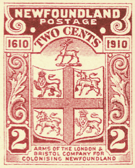London and Bristol Company facts for kids

Newfoundland postage stamp featuring the arms of the London and Bristol Company
|
|
| Public | |
| Industry | International trade |
| Fate | Dissolved |
| Founded | 2 May 1610 |
| Founders | John Guy |
| Headquarters |
,
England
|
|
Area served
|
Newfoundland |
|
Key people
|
Henry Cary, 1st Viscount Falkland |
The London and Bristol Company was a group of English merchants. They formed this company in the early 1600s. These merchants were very interested in fishing near Newfoundland.
A man named John Guy was a merchant from Bristol. He visited Newfoundland in 1608. His goal was to find a good spot for a new settlement. This trip was paid for by a group of investors.
When John Guy returned to England, 40 people wanted to start a company. They called themselves "the Tresurer and the Companye of Adventurers and planter of the Cittye of london and Bristoll for the Collonye or plantacon in Newfoundland." This long name was usually shortened to the London and Bristol Company. It was also known simply as the Newfoundland Company.
Contents
Starting a New Colony
The company wanted to create a permanent settlement in Newfoundland. This would help England claim land and control fishing. It was a big step in British colonization of the Americas.
The Royal Charter
On May 2, 1610, King James I gave the company a special document. This document was called a charter. A charter is like a permission slip from the king. It gave the London and Bristol Company special rights.
The charter gave them a monopoly on the Avalon Peninsula. A monopoly means they had the only right to do certain things there. This included farming, mining, fishing, and hunting. They had these special rights until 1616.
New Grants and Changes
After 1616, the King started giving land to other groups too. The Bristol Society of Merchant Ventures began to get new land grants. Many members of this new society had also been part of the London and Bristol Company.
Important People in the Company
One important person in the London and Bristol Company was Henry Cary, 1st Viscount Falkland. He supported the company's plans. His wife was the daughter of Sir Laurence Tanfield. Sir Laurence was one of the company's main leaders. This connection helped Henry Cary have influence within the company.
See also
- List of communities in Newfoundland and Labrador
- Bristol's Hope
- Renews, Newfoundland and Labrador

